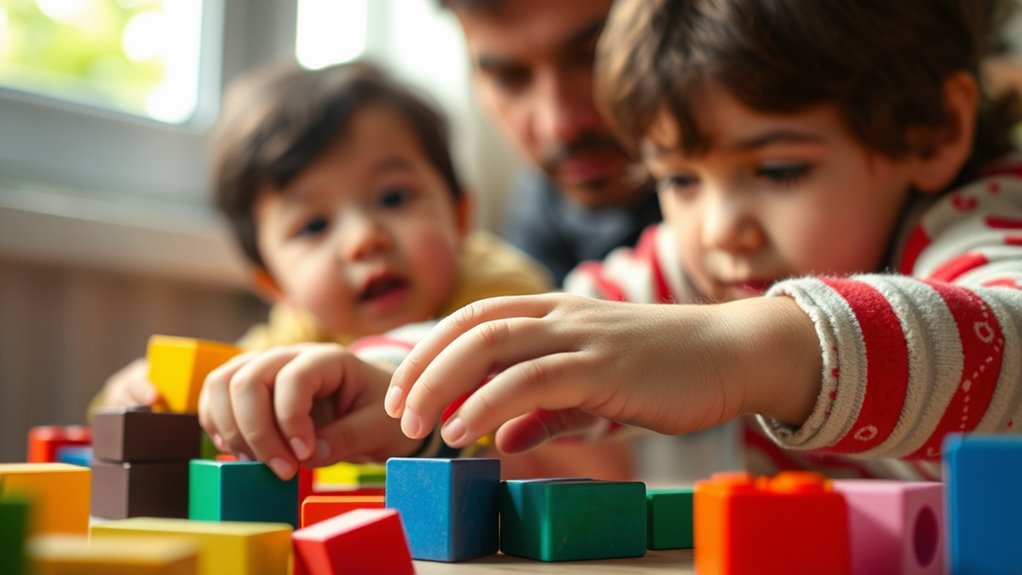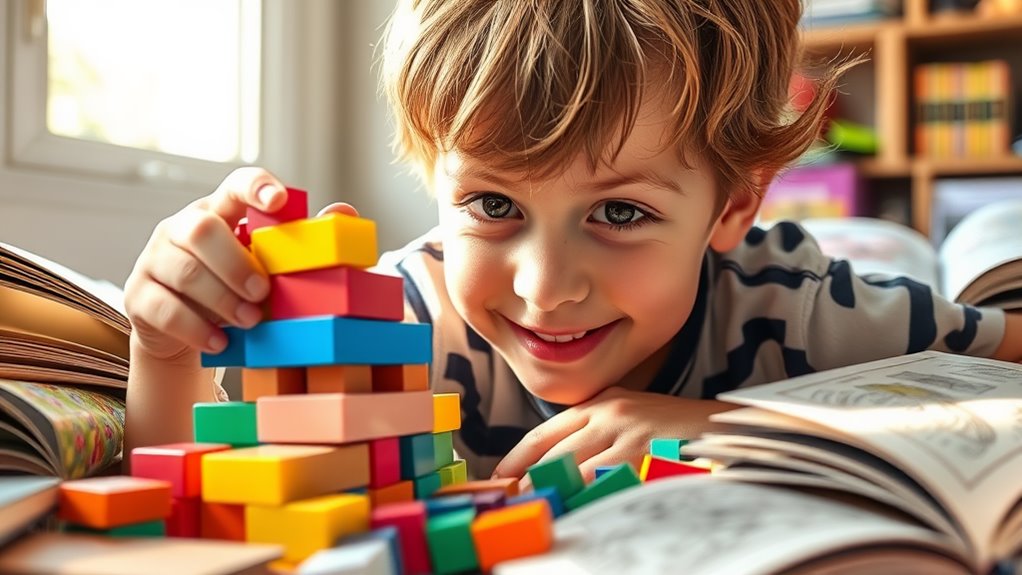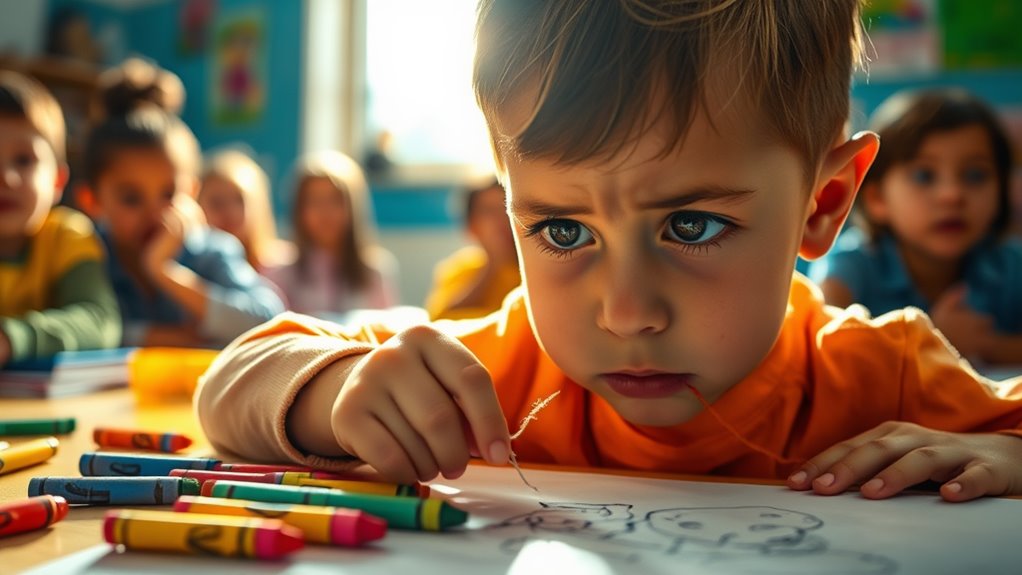How to Spot the Early Signs of Developmental Delays
To spot early signs of developmental delays, pay attention to your child’s milestones in motor skills, language, and social interactions. For infants, watch for cooing by two months and babbling by six months. By 12 to 15 months, your toddler should use simple words and gestures. Lack of eye contact or struggle to walk independently may signal delays. In preschoolers, notice their ability to share, communicate effectively, and play with peers. If you see any red flags, don’t hesitate to seek professional help. There’s much more to understand about supporting your child’s development effectively.
Key Takeaways
- Monitor cooing and babbling; lack of these sounds by two to six months can indicate communication delays.
- Observe motor skills; difficulties in reaching or rolling over by four to six months may signal developmental concerns.
- Watch for social interactions; absence of eye contact or withdrawal from play by 12-15 months can suggest social delays.
- Assess language development; failure to use simple words or gestures by 12-15 months is a red flag for communication issues.
- Seek professional evaluation if you notice consistent concerns in speech, motor skills, or social interaction for timely intervention.
Understanding Developmental Milestones
When it comes to childhood development, most parents find it helpful to understand developmental milestones. These milestones serve as a guide to what you can expect as your child progresses through various developmental stages. By keeping an eye on these milestones, you can better assess whether your child is developing at a typical rate or if there might be areas of concern.
Milestone tracking is essential; it allows you to monitor your child’s progress in critical areas like motor skills, language, and social interactions. For instance, by the age of one, many children can sit up without support and say simple words like “mama” or “dada.”
Keeping a checklist of these developmental milestones helps you identify any delays early on. If you notice your child isn’t meeting specific milestones, it’s important not to panic, as every child develops at their own pace.
However, being proactive about milestone tracking can make a significant difference in addressing potential delays. Early intervention often leads to better outcomes, so stay informed and engaged in your child’s development.
Common Signs in Infancy
Often, parents may notice certain signs in infancy that could indicate potential developmental delays. One crucial area to observe is early communication. If your baby isn’t cooing or making sounds by around two months, this could be a red flag. By six months, babies typically respond to their names and engage in babbling. If you find your little one isn’t doing these things, it’s worth discussing with your pediatrician.
Another vital aspect to monitor is motor skills. Most infants start showing basic motor skills, like reaching for toys or rolling over, by four to six months. If your baby seems stiff or floppy, or if they struggle to grasp objects, it might signal a delay.
Additionally, by nine months, many babies can sit up without support, and those who are developing typically will begin crawling around this age. If your child isn’t achieving these milestones, it’s essential to pay attention.
Keep in mind that every child develops at their own pace, but being aware of these early signs can help you advocate for your child’s needs effectively.
Warning Signs in Toddlers
Noticing warning signs in toddlers can be crucial for early intervention. During this stage, it’s important to pay attention to both toddler communication and motor skills. If your toddler isn’t using simple words or gestures by 12-15 months, it might be a red flag. They should be able to say a few words and point to objects or people. If they’re not making eye contact or responding to their name, that could indicate communication delays.
In terms of motor skills, keep an eye on your toddler’s ability to walk, run, and climb. By 15 months, most toddlers should be able to walk independently. If yours is still struggling to pull themselves up or isn’t walking by 18 months, it’s worth discussing with a pediatrician.
Additionally, notice how your toddler interacts with others. If they seem withdrawn or don’t engage in play with peers, it may suggest social delays.
Early identification of these warning signs allows for timely support, helping your child thrive in their development. Trust your instincts, and don’t hesitate to seek guidance if you’re concerned about any aspect of your toddler’s growth.
Observing Preschool Behaviors
As toddlers grow into preschoolers, their behaviors can offer valuable insights into their developmental progress. By observing their interactions during playtime, you can gauge their social skills and emotional development.
Here are three key behaviors to watch for:
-
Sharing and Cooperation: How well does your child share toys or collaborate with peers during playtime? This can indicate their ability to form friendships and work in teams.
-
Communication: Pay attention to how your child expresses their thoughts and feelings. Are they using sentences to communicate? Strong language skills are essential for social interactions.
-
Imaginative Play: Watch how your child engages in pretend play. Are they able to take on different roles and create scenarios? Imagination is crucial for social development and understanding others’ perspectives.
When to Seek Professional Help
Is your child’s development raising concerns for you? If you’ve noticed any red flags, it’s essential to seek professional help. Early signs of delays can include difficulties with speech, social interactions, or motor skills. Trust your instincts—if something feels off, it’s better to address it sooner rather than later.
Professional assessments can provide clarity and direction. You don’t have to navigate this alone; pediatricians, child psychologists, and developmental specialists can help evaluate your child’s needs. Early intervention can make a significant difference. The earlier you seek help, the better the outcomes for your child.
Remember, every child develops at their own pace, but consistent issues that raise concerns shouldn’t be ignored. If your child isn’t meeting milestones or exhibits significant differences compared to peers, don’t hesitate to reach out for guidance.
Getting the support you need can help you create a plan tailored to your child’s unique situation. Ultimately, seeking professional help is a proactive step toward ensuring your child gets the resources they need for healthy development.
Don’t wait—take action today for a brighter tomorrow.
Frequently Asked Questions
What Resources Are Available for Parents Concerned About Developmental Delays?
If you’re concerned about your child’s development, there’re plenty of resources available. Consider joining support groups for shared experiences and check online resources for articles, tools, and expert advice to help you navigate your concerns.
How Can I Support My Child’s Development at Home?
Imagine setting up a treasure hunt in your living room. By engaging in playful activities like this, you’re creating a nurturing environment that fosters curiosity and growth, supporting your child’s development beautifully at home.
Are There Specific Tests for Identifying Developmental Delays?
Yes, there’re specific tests for identifying developmental delays. You can use screening assessments and developmental checklists to evaluate your child’s progress. These tools help you pinpoint any areas needing additional support or intervention.
What Role Do Genetics Play in Developmental Delays?
You might think genetics don’t matter much, but they do. Genetic predisposition and familial influences shape development significantly, impacting how children grow and learn. Understanding this can help you support their unique journeys better.
How Do Cultural Differences Affect the Perception of Developmental Milestones?
Cultural perspectives heavily influence milestone expectations. You might notice that what’s considered typical in one culture can differ significantly in another, affecting how individuals view development and the importance placed on achieving certain milestones.





